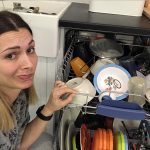Natalia is a great cook. But that’s not what matters here. Her supernatural power is great contact with people and master level empathy. She’s sincere, direct and very active. Let me introduce you Natalia Bujak, the President of the Polskie Dzieci Foundation, which actively creates trends in healthy and reasonable nutrition. She has invented health-oriented school shops „Zdrowik”, places created together with parents to teach children how to eat and what to eat.
There are more and more obese children in schools.
We don’t want to generalize – we all know pretty well that the awareness of our society is increasing, but this doesn’t change the fact that Poland is among the top five European countries in terms of obesity, and here we’re not talking about adults only – children too.
Can you tell us how bad it is? What do you think about our children’s fitness today and their attitude towards food?
Kids are not to be blamed for their attitude towards food – they eat what they get from their parents. Their habits come from home and the school – so the fitness itself is not bad in my opinion, but it can always be better. It is important to appeal to parents, educators, to draw more attention to what children eat, what they bring to school. If the subject gets more publicity – a change for the better is possible;)
Natalia, are Polish parents aware of the influence they have on their children’s eating habits?
Here, at the foundation, we frequently hear that parents don’t realize that they make mistakes when it comes to feeding their children. If your child has an appetite, there’s nothing to be worried about, right? If they don’t want to eat vegetables, they get energy from a bowl of chips and it’s fine.
How often do parents reward their children with sweets?
I often hear: „when you clean up your room, you’ll get a chocolate bar”, “don’t weep anymore, I have something sweet for you”. I wonder if the child really deserves to be rewarded for good behaviour? Whether parent’s peace and quiet should depend on such behaviour. Sweets aren’t a reward. Sweets were, are and will be present and there’s no need to go to extremes – sweets can be eaten, but we ought to think about the amount of sweets given and how often they are served to children. I know parents who can choose high-quality sweets for their children. Dates are a great example here and I always recommend them as „sweets”.
And what do you think about products „designed with Your child in mind”?
Colourful water, juices labelled with a phrase that they are designed for children, for example, are a hoax. There is nothing better than clean water, water and water again. „But my child wants to drink and he doesn’t want to drink water”. If he doesn’t want to drink it now – it’s not that surprising, he’s used to sweet drinks and we can’t change it immediately. What we need is time and consistency.
Recently, I’ve explained to my daughter that vitamins in the form of jelly are not vitamins, they are jellies. My daughter persistently repeated that they’re vitamins, and I was consistently answering – no, it’s still just sweets and jellies. TV commercials don’t help parents at all….
A child seeing colourful labels on the products immediately screams loudly „Mom, mom, I want this water” – and you reach for it, because the child wants it – you don’t check the ingredients, you don’t verify it. Because the child wants it! This is a standard trick. One of the producers of breakfast cheese uses in its commercials a character that as a mascot can be given to children when you buy more cheese and the child wants this very cheese to get the toy. How to get around this? It is better to choose a high quality yoghurt and buy a mascot separately than buy yoghurt with a few teaspoons of sugar and artificial dyes.
What are the most common mistakes you encounter in feeding children?
Fries are not vegetables! Of course, potatoes are, but I urge you to think about the form in which they can be given to your child so that they are healthier than those served from deep fat baths. We recommend French fries made from sweet potatoes, their taste appeals to children and they can sprinkle them with colourful spices before placing them in the oven:) Fries made from apples served with a natural yoghurt sauce or with a raspberry ketchup are also great.
I bet that’s not all.
There are three more, strong points. For example giving up or lack of consistency. „Because Mickey doesn’t like carrots, peas and lettuce”. He tried it once and didn’t like it – maybe it’s a question of preparation. I often realize that children „eat with their eyes”. It may seem trivial, but it is worth thinking about how to serve meals to a fussy child. It is also worth thinking about why meals seem monotonous – maybe this is because parents don’t seek inspiration, don’t know that a dish other than potatoes with cutlets and salad takes much less time and at the same time can be much more nutritious and varied? The Internet is full of recipes telling us „Make a nutritious dinner in 20 minutes”. You just need to want to, take some time to look for inspiration and new flavours. It is also a common mistake to choose products that are represented by ready-made hamburgers, dumplings with a month’s expiry date, lasagne with ingredients list as long as an introduction to a good book. Chemistry at its best! The longer the composition, the more crap inside. If you select ready-made products, try to choose a good and proven gourmet food – and the selection is getting wider and wider.
And what about the sweet gifts that your child gets? Taking them away seems a little bit awkward….
What if my aunt, grandmother, uncle or friend drops by with a chocolate bar, one Kinder surprise? Of course, it’s hard to say – don’t give it to my child, I’m the one who decides what and when it should eat! I think it’s time to say STOP. I know firsthand that when given fruit which he or she has never eaten before, a child is extremely excited. Coconut, melon, mango – there’s plenty to choose from. Perhaps parents can suggest that the gift should be something that will stimulate child’s creativity? I am in favour of speaking openly about our expectations and not allowing sweet gifts. It is we who decide when our child eats sweets. It’s that simple!
I know that I set an example for my child. What I am buying today, she’ll be buying in 15 years’ time, and I say that I know what is good for her and I can always explain why I don’t buy her a pack of sweets and yoghurt with colourful balls.
If you&’re not a role model for your child, you won’t show him or her what is good, you won’t explain why Coca Cola is unhealthy – your child will want to drink this smoky drink. We set a main example for our child. With the time you devote to your child, you determine his or her nutritional development. Believe me, I hear more and more often that children are sharing water, because others who drink sweetened juices are still thirsty. Children who have conscious parents are able to convince their peers to change their habits. That is a fact, I believe it will get better and better.
Me too. In the end, my decision is final.
You decide whether you are a conscious parent and whether you want your child to thank you for this in a dozen or so years’ time. Following this path is not easy, but if you don’t let it go, if you believe that you can eat reasonably, you’ll set the best example for your child. You already have 🙂 The best confirmation is when we hear: „my child eats spinach”, “my child eats oat flakes with a smile”, „your power balls have become a hit in our house”. The teaching staff who regularly eat in our shops order our salad dressings for the weekend, and we prepare them on the spot because they are impossible to falsify 🙂 We are happy when we go to school at 7:30 and a parent knocks on our window and orders take-away cocktails.
And often parents shift the responsibility for a healthy meal onto their children. It’s enough to give them 5 PLN and problem disappears.
Giving your child money for lunch isn’t wrong. The mistake here is that a child doesn’t know what to buy and takes what is colourful, not necessarily healthy. Dear Parents, talk to your children about what lunch should look like, what they can buy for 5 pln. Collecting receipts is a good idea, as well as praising your child and talking about food products.
Let’s say that in my fridge there’s sweet cheese and fizzy drinks, there is white bread, and vegetables come mainly in the form of ketchup served with sausages. How do I start looking after my child’s health?
First of all, you need to realize why you have what you have in your fridge and whether it’s actually of poor quality. And then choose diversity. You see, kids have to be given an alternative – if they drink water, eat fruit, are eager to reach for vegetables from the very beginning, it will be a norm for them. But the implementation of such standards depends on parents 🙂 The school shop we’ve opened in Oleśnica can serve as an example here – the lady who runs the shop told us that graham rolls won’t sell, because kids don’t like them. And what happened? Good quality cheese, ham, real butter and fresh vegetables aesthetically served are a hit among schoolchildren.





























